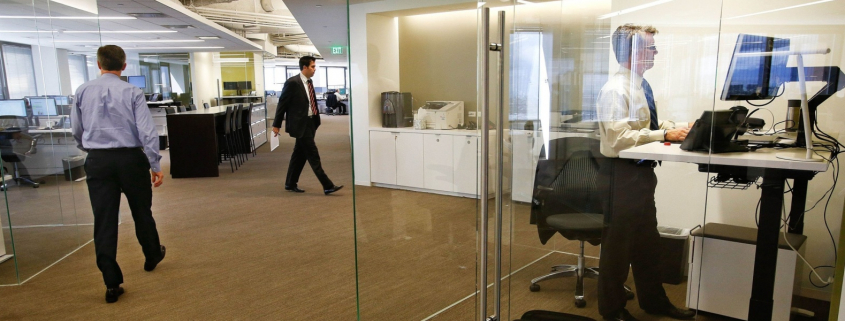In this office, there are no cubicles, no lavish corner suites for executives and very few filing cabinets.
Employees hustle about, plugging in laptops and hooking into phone lines at any desk that’s convenient. A giant video screen overlooks a cafe where employees can conduct business in an informal setting, grab a bite or maybe catch an inning or two of the San Francisco Giants game.
This could be the headquarters of Google, Facebook or maybe Apple. But it’s not. It’s the 24th floor of 500 Capitol Mall, where the Sacramento office of commercial real estate services firm CBRE is test-driving an emerging concept in workplace design. Can a modern, perk-laden, almost-paper-free office be better for business? Los Angeles-based CBRE Group Inc., which has more than 40,000 employees and 300 offices worldwide, thinks so.
The transformation of its Sacramento office is part of a global CBRE initiative, known as “Workplace360”. It was implemented last year in Los Angeles and earlier this month in Orlando, Fla. The Sacramento office makeover is the fifth CBRE transition in the United States; more than two dozen CBRE offices worldwide are converting to the model in 2014. It’s intended to save space, promote collaboration, offer more flexibility, trim costs and even help attract the next generation of younger employees.
It’s also part of a trend in workplace design, commonly referred to as “untethered” or “free address” office space. With the advent of mobile technology, some companies are abandoning traditional office cubicles, in favor of shared or communal workspace. In a 2008 survey of 950 companies, about 60 percent said they had some kind of “unassigned workspace,” according to the International Facility Management Association, a trade group of facility managers.
For the local CBRE office, the recent move represents a major shift, physically and philosophically. In its first Sacramento office relocation in more than 40 years, the company only moved across the street but entered into a completely new way of operating. At its former offices, at 555 Capitol Mall, CBRE was spread out over three floors, with most employees working in traditional cubicles. High stacks of paper and rows of filing cabinets were the norm.
At its new address, all operations are on one floor, encompassing about 17,500 square feet. Mountains of paper have been all but banished. Each employee was allowed to bring one filing cabinet to the new office, which meant purging, scanning and recycling old files. With no assigned desks, CBRE’s Sacramento employees – about 100 in all – can plug in anywhere. Each has a company-issued laptop with Wi-Fi access to printers and digital files, as well as a virtual private network that lets them securely connect to their office documents from anywhere in the world. According to the company, ahead of the move, employees purged 500,000 paper documents, many of which are now accessed digitally by “key word” searches from their laptops.
Each desk is fully equipped with pens, highlighters, notepads, even a bottle of hand sanitizer. When employees leave at night, every desktop is “100 percent clear,” except for a phone, computer mouse, blue-tooth headsets and dual computer monitors. That “clean desk” policy applies to everyone, from top executives to junior staffers. David Brennan, senior managing director of CBRE Sacramento, said the everything-on-one-floor concept alone “was huge for us. It encourages a more collaborative environment.” Additionally, the firm’s new offices serve as a “real-world example” for corporate clients, who often seek advice on incorporating new workplace technologies, he noted.
“Workplace360” was launched after CBRE officials did extensive research on office designs that would foster mobility and flexibility, but also consolidate workspace to encourage more teamwork, as well as reduce square footage requirements. CBRE officials believe there’s a payoff in collaboration among the company’s many commercial real estate divisions, which range from financing and property management to a unit that specializes in auto dealership transactions.
Research showed that its brokers and staff typically spent about 50 percent of their time working with others and the other half working alone. Employees are encouraged to work in “neighborhoods” of colleagues doing similar tasks. There are seven “huddle rooms,” where small teams can meet for conferencing and video presentations. There are also single-person “focus rooms” when privacy is a must.
It can be an adjustment for longtime employees used to sitting at the same desk every day, perhaps surrounded by personal photos and mementos. “There was some anxiety at first,” said Chris Schempp, who oversaw hundreds of details as director of CBRE’s in-house project team during the 15-month planning and moving process. “But as things started coming together, you could tell that more (employees) were buying into the concept.”
Each employee has a personal, locked filing cabinet, which some use to keep family photos that they prop up on whatever desk they’re using that day. There also are banks of lockers for storing laptops, briefcases or other personal items and a coatroom where suits and ties can be stashed for client meetings.
Amy DeAngelis, the CBRE Sacramento senior vice president who brokered the deal for the 24th floor space and the 11-year lease in the office building owned by Tsakopoulos Investments, said care was taken to make sure CBRE workers could utilize space efficiently, “which affects the bottom line financially.” The elimination of nearly 1,320 square feet of filing cabinet space alone will yield an estimated $453,000 savings in storage costs, during the lease term.
The new office design also takes into account employee health and wellness. Desktops, which have an antimicrobial coating to prevent retention of germs, can be height adjusted at the touch of a button. Stand-up work stations give employees the option of taking a break from their self-adjusting ergonomic chairs. Strategically placed treadmill “walk stations” enable employees to burn off nervous energy without bothering others. Subtle white noise fills the office, muffling what could otherwise be an annoying cacophony of dozens of brokers talking to clients on phones. The building also has a fitness gym and bike-to-work lockers and showers.
Perhaps the most eye-popping perk is the cafe area’s video screen that can, with Google Earth technology, zoom in on virtually any spot on the globe. Brennan said the ability to scope out every angle of a commercial real estate site – remotely – saves enormous amounts of time and money. “Think of all it would take to make a trip to, say, Chico, and do all that work on the ground,” he said. “Here, we can get a detailed look at any property and its surroundings in minutes.”
CBRE is pursuing “green building” certification for its 24th-floor office, under the Leadership in Energy and Environmental Design rating system, which requires meeting stringent environmental standards in construction and operation, including reduced water use and renewable energy sources.
The “Workplace360” model also is designed to attract the next generation of employees – particularly young, tech-savvy workers who are likely to be drawn to offices similar to those of high-powered, Bay Area tech companies. “If you have the resources to remake your office setting, it’s a good way to go,” said Peter Schaub, a New York-based marketing and branding expert. “Talented millennials who have the skills to be in demand aren’t necessarily thinking like their parents. Pay and benefits still count of course, but they put high emphasis on the look and feel of a workplace. “It could make the difference between landing talent, or not,” said Schaub. “If you have a recruit say, ‘Wow, I get to work in a place that looks this cool,’ you’ve probably got them hooked.”
The company doesn’t divulge what it spent on all of its new office technologies, but considers it a long-term investment. “It was not so much a cost-saving initiative but an investment in our employees and the workplace of the future,” said CBRE consultant Matt Fritsch. Now, when he visits the company’s traditional offices in Roseville and Stockton, those office environments seem so “foreign,” he said. “For employees who enjoy a clutter-free environment, this is a beautiful place to be.”
Source: The Sacramento Bee




